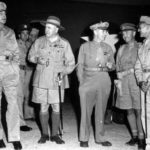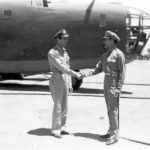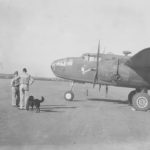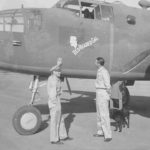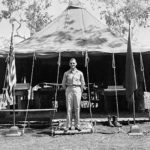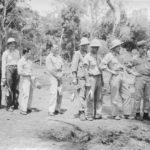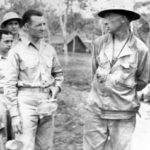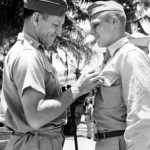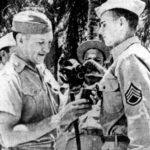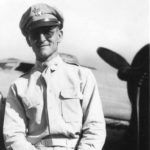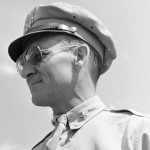On June 17, 1942 Kenneth N. Walker was promoted to Brigadier General then assigned to the South-West Pacific Area (SWPA) and flown with Brigadier General Ennis Whitehead arriving in Australia on July 11, 1942.
Immediately, Lieutenant General George Brett sent Walker and Whitehead on an inspection trip. In New Guinea, Walker flew three combat missions and survived an air raid against Port Moresby.
In his first taste of combat, Walker flew as an observer aboard a B-17 Flying Fortress from the 19th Bombardment Group on solo reconnaissance mission to search for a Japanese convoy. Flying at 6,000′ the B-17 spotted the convoy and circled to climb to 10,000′. In a letter to his sons, Walker wrote: “Fortunately, there were no Zeros around, although I was foolishly disappointed for a while.” The ship’s anti-aircraft guns opened fire up with “shell fragments sounded like hail on the wings, and we got one fair-sized hole in the right wing. It was my first time under fire, but I was so interested that I forgot to feel concerned.”
On July 22, 1942 Walker flew as an observer aboard a B-25 Mitchell from the 3rd Bombardment Group, 13th Bombardment Squadron against Japanese landing off Gona on the north coast of New Guinea. That same day, he also flew as an observer on a B-26 Marauder from the 22nd Bombardment Group that searched for the Japanese convoy headed back to Rabaul.
For his role in these actions in July, Walker earned the Silver Star in August 1942.
In Australia, Walker was based in Garbutt Field at Townsville, Queensland Australia. He took command of Allied Air Forces in northeast with the aid of Royal Australian Air Force (RAAF) Group Captain William H. Garing. Under Walker’s command were units in Townsville, Cairns, and Horn Island. Walker was given the authority to reorganize the northeast command area which General Kenney had described as a “scrambled outfit of Australians and Americans [that] resembled a can of worms.” In Townsville, Jan Arthur was assigned as his personal driver.
General Walker in Australia 1942
Photographs of General Walker in Australia.
In early August 1942, Walker accompanied a civilian from Washington DC on a classified mission to gather information about potential uranium deposits in Australia. On August 4, 1942 the pair flew from Townsville to Darwin to meet with Australian officials. Two days later they traveled to Alice Springs then back to Townsville.
On September 3, 1942 Walker was appointed as Commanding General (C. G.), V Bomber Command (5th BC), 5th Air Force and was headquartered at Garbutt Field in, Townsville in Queensland, Australia.
In Australia, he was assigned B-25C “Red Headed Gal” 41-12797 as his personal aircraft. An active pilot, Walker personally flew between Townsville and Port Moresby in this aircraft in 1942.
B-25C “Red Headed Gal” 41-12797
General Walker with his personal aircraft in Australia.
On September 3, 1942 5th Bomber Command was formed. On September 4, 1942 General Douglas MacArthur wrote to express his approval of Walker’s performance thus far.
Dear Walker:
I want to tell you how delighted I am at your splendid work. The improvements in the efficiency of the Air Corps has been marked since you assumed command. I fully expected it but am very proud at its realization.
Cordially yours,
Douglas MacArthur
During the middle of September 1942, Walker was sent to Port Moresby to oversea the 5th Air Force advanced echelon (5th ADVON). Conditions were primitive and air crews were overworked.
“Gen Walker faced a heavy burden with supervising the raids on Rabaul, while doing everything in his power to see that the enlisted men as well as the officers were being taken care of. He demanded that the food be improved in the enlisted men’s mess and was indeed an “enlisted man’s general”. When both officers and men had to wait in the same chow line an incident occurred which the men talked of for many months to follow. The general came to the chow line when it was about a block or longer and took his place last in line. A corporal offered him his place, one step closer to the food. The general refused saying he could wait his turn behind the corporal. About that time a young, second lieutenant walked ahead of the whole line, edged his way to the food counter. General Walker, standing at the end of the line, stepped up, took the upstart by the arm and led him to the rear of the line to wait his turn demonstrating to the offender that it sometimes takes more than an act of congress to make a gentleman.”
– Major Bernhardt L. Mortensen, V Bomber Command
Walker distinguished himself to those under his command as willing to stand in chow lines, wear open neck khakis, treating his men as equals and was not above typing his owner reports when things got tight. One of his clerks described Walker as “the best soldier I ever knew, from every point of view. Even without externals of rank, you knew he was the general.”
General Walker in Port Moresby 1942
Photographs of General Walker in Port Moresby.
Walker met many distinguished visitors including World War I ace pilot Captain Edward “Eddie” Rickenbacker on a Pacific inspection trip. Also General Hap Arnold, Chief of the Air Force during his tour of the South West Pacific Area (SWPA) at the end of September 1942.
On October 5, 1942 at Port Moresby, Walker bestowed the Purple Heart award to three officers and eleven enlisted men of the 703rd Ordnance Company, 8th Service Group for removing bombs and ordinance during an accidental fire that was burning in a bomb dump. In the early months of World War II, the Purple Heart award was bestowed for meritorious performance of duty and valor, in addition to wounds or death in combat.
In an award ceremony covered by war correspondents and Army photographers, Walker pinned the Purple Heart on each recipient. Several photographs of the award ceremony were published in U.S. newspapers.
An ACME photo of “Long Island Boy Honored For Courage” showing Private Martin J. Zimmermann, 32164390 of Ozone Park, Long Island receiving the Purple Heart. Brigadier General Kenneth N. Walker is wearing a garrison cap and holding a swagger stick.
An Associated Press (AP) photos show “Three Hoosiers Decorated” including SSgt Sheldon D. Nearing, 06990267 of Hammond, Indiana receiving his Purple Heart, plus portraits of two other Hoosiers: Private Glenn V. Greenfield, 15084229 of Garrett, Indiana, and Private Oliver T. Beyer of Warsaw, Indiana.
One recipient, SSgt Julius Schellenberg, 32114651 of Brooklyn, New York wrote about the award ceremony in his diary:
“Two days ago [October 5, 1942] I got the “Purple Heart”, together with the others who were with me in the ammunition dump. It was quite an impressive ceremony when the company fell out at one o’clock, dressed in their best and cleanest khaki uniforms. There seem to be all the war correspondents and newsreel men on the island. For them the whole company paraded and then we took our place, waiting for the General to arrive. We didn’t have to wait long. The command: “Present Arms” was given and the General dismounted from his command car. Then Capt. Welch read each man’s name and the deed he did. Singularly, we came up, in front of the company, as our names were called and General Walker pinned the “Purple Heart” on our chests. He spoke to each one of us, congratulating and shaking hands with us. Then he spoke to the whole company. Newsreel men were busy, taking our pictures. The newspaper men were swarming around us, getting our names, addresses and what not! It was something to write home about.”
– Diary of S/Sgt Julius Schellenberg, October 7, 1942
On October 15, 1942 Walker attended an award ceremony for aircrews from the 19th Bombardment Group at Mareeba Airfield in Queensland, Australia. Also in attendance was Major General George C. Kenney (C.O., 5th Air Force) and Lt Colonel Richard H. Carmichael (C.O. 19th Bombardment Group). LIFE photographer George Strock took extensive photographs of the ceremony that were later used in a news wire story “Nemesis of Big Jap Force”.
General Walker at Mareeba Airfield, October 15, 1942
Award ceremony photos by George Strock.
In November 1942, Walker was in Port Moresby when his friend, World War I ace Edward “Eddie” V. Rickenbacker visited to deliver a secret message to General MacArthur. The message from U.S. President Franklin D. Roosevelt to reprimand MacArthur for negative public comments about his administration and disparaging cables sent to General Marshall. Touring Port Moresby, Rickenbacker met senior officers including his old friend Kenneth Walker and toured 14 Mile Drome to meet fighter pilots.
Rickenbacker wrote about his visit in LIFE Magazine “Pacific Mission – Part III” February 8, 1943:
“I have mentioned meeting my friend General Walker at General MacArthur’s headquarters.” The article was published after Walker went Missing In Action (MIA) and Rickenbacker saluted his friend: “I should have written the late General Walker [after my visit to Port Moresby]. On Jan. 11 a communiqué announced that he was missing in action. He had last been seen over Rabaul, leading a bombing attack. Generals like Ken Walker don’t die in bed.”
On January 1, 1943, Walker flew as an observer aboard a B-24D Liberator 41-24077 from the 90th Bombardment Group, 320th Bombardment Squadron that took off 5 Mile Drome (Ward) near Port Moresby on a bombing mission over Rabaul.
Diary of Lionel B. Potter – January 1, 1943
“We took off at 01:15 and proceeded to Rabaul through some more horrible weather. The weather was so bad tonight, or this morning, that I honestly didn’t think we were going to get back. We were at 25,000 feet until we got right over the target. During that 3 hour flight from Moresby to Rabaul, we ran into everything: rain, sleet, ice of all descriptions and it was rough as a cob. Why we didn’t turn back I don’t know, unless it was that Capt. Taylor didn’t want to initiate the move and the General didn’t want to show weakness by suggesting. So we merrily flew on through the worst storm I ever hope to have the displeasure to fly through, on tops of the weather, I had given Gen. Walker by co-pilots position.”
Arriving over the target at 6:45am they found the target area covered by clouds aside from Simpson Harbor which was clear with approximately 100 vessels inside. The B-24 made a bomb run from approximately 8,000′ against a large transport but the bombs did not release, nor did they on a second bomb run. Targeted by anti-aircraft fire and intercepted by Zeros, B-24 turned back to base and escaped into clouds. Aboard, the gunners claimed two Zero shot down that were verified by General Walker. This B-24 returned with the bombs aboard, landing back at 5 Mile Drome (Ward) by 10:00 am.
On January 5, 1943 Walker flew his final mission an observer aboard B-17F “San Antonio Rose” 41-24458 over Rabaul. He and his crew went Missing In Action (MIA).

